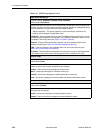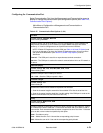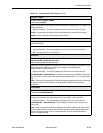
4. Configuration Options
9700-A2-GB20-20 December 2002 4-59
Configuring the Communication Port
Select Communication Port from the Management and Communication menu to
display or change the communication port configuration options (see Ta bl e 4 - 25 ,
Communication Port Options).
Main Menu Configuration Management and Communication
Communication Port
Table 4-25. Communication Port Options (1 of 4)
Port Use
Possible Settings: Terminal, Net Link
Default Setting: Terminal
Assigns a specific use to the COM port. It can be configured as a communications link
that provides connectivity to an IP network (to support SNMP managers and Telnet
sessions), or it can be configured as a an asynchronous terminal interface.
NOTE: If Default IP Destination is set to COM (see Table 4-18, Node IP Options) and
Port Use is changed to Terminal, the Default IP Destination option is forced to None
and Initial Route Destination (see Table 4-23, SNMP Traps Options) is set to
AutoRoute.
Terminal – The COM port is used for an asynchronous terminal connection.
Net Link – The COM port is used as the network communications link to an IP network or
IP device.
Data Rate (Kbps)
Possible Settings: 9.6, 14.4, 19.2, 28.8, 38.4, 57.6, 115.2
Default Setting: 19.2
Specifies COM port rate in kilobits per second.
9.6 – 115.2 – Sets the COM port speed in Kbps.
Character Length
Possible Settings: 7, 8
Default Setting: 8
Specifies the number of bits needed to represent one character.
7 – Sets the character length to seven bits. Not available if Port Use is set to Net Link.
8 – Sets the character length to eight bits. Use this setting if the COM port is used as the
network communication link (Port Use set to Net Link).
Parity
Possible Settings: None, Even, Odd
Default Setting: None
Provides a method of checking the accuracy of binary numbers for the COM port. A parity
bit is added to the data to make the “1” bits of each character add up to either an odd or
even number. Each transmitted data character is approved as error-free if the “1” bits add
up to an odd or even number as specified by this option.
None – Provides no parity.
Even – Makes the sum of all 1 bits and the corresponding parity bit even.
Odd – Makes the sum of all 1 bits and the corresponding parity bit odd.


















